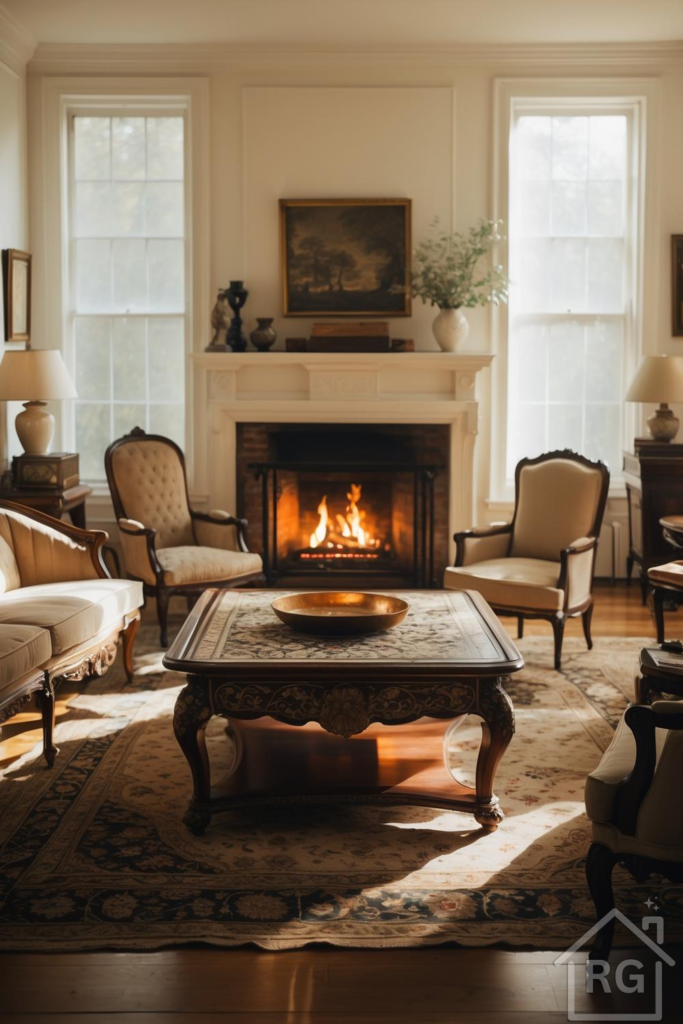
Step into a realm where history whispers through every detail and comfort reigns supreme. The colonial style living room, as beautifully exemplified in this image, offers a timeless sanctuary that blends classic elegance with inviting warmth.
Far from being merely a historical relic, this aesthetic continues to captivate with its emphasis on quality craftsmanship, natural materials, and a serene, balanced atmosphere. It’s a design philosophy that speaks to a desire for enduring beauty and a home that feels both grand and intimately cozy.
The Essence of Colonial Style
Colonial style, particularly in interior design, draws its inspiration from the homes of early American settlers, evolving through various periods like Georgian and Federal. It’s characterized by a sense of order, symmetry, and a deep appreciation for natural resources.
Think sturdy, well-made furniture, often crafted from rich woods, and a palette that reflects the natural world. This style prioritizes functionality without sacrificing beauty, creating spaces that are both practical for daily life and impressive for entertaining. The living room pictured here perfectly encapsulates these principles, offering a masterclass in how to achieve a look that is both historically resonant and utterly comfortable for modern living.
Color Palette: A Foundation of Warmth
The visual harmony of this colonial living room begins with its exquisite color palette, which is predominantly warm and inviting. The walls and much of the upholstery are rendered in a soft, creamy off-white, providing a bright and airy backdrop that allows richer tones to truly sing. This neutral base ensures the room feels spacious and bathed in light, especially with generous natural illumination.
Contrasting beautifully with the light walls are the deep, warm browns of the polished wood furniture—from the ornate coffee table to the sturdy armchairs and side tables. These rich, earthy tones ground the space, adding a sense of gravitas and tradition. The fireplace, a central feature, introduces the rustic charm of brick in a warm, reddish-brown hue, further accentuated by the flickering amber and orange glow of the fire within. This element not only provides physical warmth but also infuses the room with vibrant, living color.
The large area rug introduces a sophisticated blend of tan and beige as its primary field, adorned with intricate patterns in darker shades, including hints of deep forest green or slate gray. These darker accents provide visual interest and depth without overwhelming the overall lightness. The metallic gleam of a brass bowl and lamp bases adds subtle touches of golden warmth, reflecting light and enhancing the room’s luxurious feel. This carefully curated palette ensures a cohesive and deeply comforting environment, where every color contributes to an overarching sense of serene elegance.
Furnishing Your Colonial Living Room
Seating: Comfort and Elegance
In a colonial living room, seating is designed for both comfort and formal elegance. The sofa, with its plush, light-colored upholstery and beautifully carved wooden frame, invites relaxation while maintaining a refined aesthetic. Its classic lines and sturdy construction are hallmarks of the style. Flanking the fireplace, the two armchairs echo this design, featuring tufted backs and smooth, comfortable cushions in a complementary cream fabric. Their dark wood frames, with their graceful curves and detailed carvings, provide a striking contrast to the lighter upholstery, highlighting the craftsmanship inherent in colonial furniture.
The Heart of the Room: Coffee Table
The ornate coffee table takes center stage, a true masterpiece of colonial design. Its dark, polished wood is intricately carved, showcasing a level of detail that speaks to artisanal quality. The tabletop itself appears to be inlaid or patterned, adding another layer of visual texture and interest. This piece is not just functional; it’s a significant decorative element that anchors the seating arrangement and draws the eye, serving as a focal point around which conversations and gatherings naturally revolve. The simple, elegant brass bowl placed upon it adds a touch of understated luxury.
Accent Pieces and Storage
Complementing the main seating, various side tables and a console table or cabinet provide practical surfaces and additional storage. These pieces maintain the consistent use of dark, rich wood, reinforcing the room’s traditional character. They are perfectly sized to hold table lamps, books, or decorative objects, contributing to the room’s lived-in yet orderly feel. Each piece, though perhaps less prominent than the coffee table, plays a crucial role in completing the room’s functional and aesthetic requirements.
Textures and Materials: A Rich Tapestry
The colonial living room is a symphony of textures, each contributing to the overall sensory experience and visual richness. The dominant material is wood, appearing in various forms: the highly polished, dark surfaces of the coffee table and other furniture, the intricate carvings that adorn the frames of the chairs and sofa, and the warm, inviting tones of the hardwood floor. These wooden elements provide a sense of solidity and timelessness.
Softness is introduced through the fabrics. The plush, tufted upholstery of the armchairs and the smooth, inviting texture of the sofa’s cushions offer tactile comfort, inviting one to settle in. The large area rug, likely made of wool or a similar natural fiber, adds another layer of softness underfoot, while its intricate pattern provides visual texture and a sense of history. The rough, earthy texture of the brick inside the fireplace contrasts with the smooth, painted mantel, creating a dynamic interplay of surfaces.
Metallic accents, such as the brass bowl and lamp bases, introduce a subtle sheen, reflecting light and adding a touch of refined elegance. Glass in the large windows allows natural light to flood the space, while the ceramic or porcelain of the lamps and vases adds a delicate, smooth finish. This thoughtful combination of diverse materials—from the sturdy and robust to the soft and delicate—creates a multi-layered environment that is both visually stimulating and deeply comforting.
Lighting and Ambiance
Lighting plays a pivotal role in defining the ambiance of this colonial living room. The large, multi-paned windows are a key feature, allowing an abundance of natural light to stream in, illuminating the space and highlighting the rich textures and colors. The soft, diffused daylight creates a serene and airy atmosphere during the day, making the room feel open and inviting.
As evening approaches, the room transforms with the warm glow of artificial lighting and the mesmerizing dance of flames in the fireplace. Elegant table lamps, strategically placed on side tables, cast a soft, ambient light, creating pockets of warmth and intimacy. But it is the crackling fire in the hearth that truly brings the room to life, casting a golden, flickering light that dances across the walls and furniture, creating a cozy and romantic atmosphere. This combination of natural and artificial light sources ensures the living room is welcoming and comfortable at any time of day or night, perfectly embodying the cozy spirit of a colonial home.
Decorative Elements: The Finishing Touches
The Fireplace: A Focal Point
Beyond its function as a heat source, the fireplace serves as the undeniable focal point of this colonial living room. Its classic white mantelpiece, adorned with elegant moldings, provides a perfect stage for carefully selected decorative items. A traditional landscape painting hangs above, its muted tones complementing the room’s palette and adding a touch of classical art. Flanking the painting are various decorative vases and sculptures, their dark hues providing contrast and visual weight, contributing to the room’s balanced symmetry.
Rugs: Grounding the Space
The large, ornate area rug is more than just a floor covering; it’s an integral part of the room’s design. Its intricate, traditional pattern in shades of tan, beige, and darker accents like deep green or slate gray, grounds the seating arrangement and defines the living area within the larger room. The rug adds warmth, absorbs sound, and introduces a layer of historical authenticity and visual richness that ties all the elements together.
Subtle Greenery
A simple vase of delicate white flowers on the mantelpiece provides a subtle touch of natural beauty and freshness. This small detail adds a living element to the room, softening the more formal lines of the furniture and decor, and introducing a hint of organic grace. It’s a reminder that even in a historically inspired space, a touch of nature can bring vitality and charm.
Bringing It All Together: Design Principles
The success of this colonial style living room lies in its adherence to fundamental design principles. Symmetry is evident in the placement of the armchairs flanking the fireplace and the balanced arrangement of mantel decor. This creates a sense of order and calm. Proportion is also key, with furniture pieces scaled appropriately for the room, ensuring that no single item overwhelms the space. The careful balance of light and dark elements, soft and hard textures, and ornate and simple forms contributes to a harmonious and visually appealing environment. Every element feels intentionally placed, contributing to a cohesive and inviting whole.
Tips for Your Own Colonial Living Room
- Embrace Natural Materials: Prioritize furniture made from solid, dark woods like mahogany, cherry, or walnut. Look for pieces with carved details or classic lines.
- Choose a Warm Color Palette: Start with a base of creamy off-whites or soft beiges for walls. Introduce warmth with rich browns, deep reds, and muted greens or blues in upholstery, rugs, and accents.
- Invest in Quality Upholstery: Select sofas and armchairs with comfortable, durable fabrics in traditional patterns or solid, neutral tones. Tufting and rolled arms are classic colonial features.
- Feature a Fireplace: If possible, make your fireplace a central feature. Adorn the mantel with classic art, antique-inspired vases, and symmetrical arrangements.
- Layer with Ornate Rugs: A large, traditional area rug with intricate patterns will define your living space and add significant warmth and character.
- Incorporate Traditional Lighting: Use table lamps with classic bases (like brass or ceramic) and soft, ambient light. Consider sconces or a chandelier for additional period charm.
- Add Historical Details: Look for decorative accessories like antique maps, brass objects, porcelain figurines, or landscape paintings to enhance the colonial feel.
- Prioritize Comfort: While elegant, colonial style is also about creating a welcoming home. Ensure your seating is plush and inviting, and add throws or pillows for extra coziness.
- Maintain Symmetry: Arrange furniture and decor in a balanced, symmetrical manner to achieve the orderly and formal yet inviting look characteristic of the style.
- Let in Natural Light: Keep window treatments simple to maximize natural light, which enhances the warmth and openness of the space.
This colonial style living room is more than just a beautifully decorated space; it’s an invitation to experience comfort, history, and enduring elegance. By carefully selecting furniture, embracing a warm color palette, and layering rich textures, you can create a living room that feels both grand and intimately personal. It’s a testament to the power of classic design to create spaces that truly feel like home, offering a serene retreat from the modern world. We hope this detailed exploration inspires you to bring the timeless charm of colonial design into your own living space.
